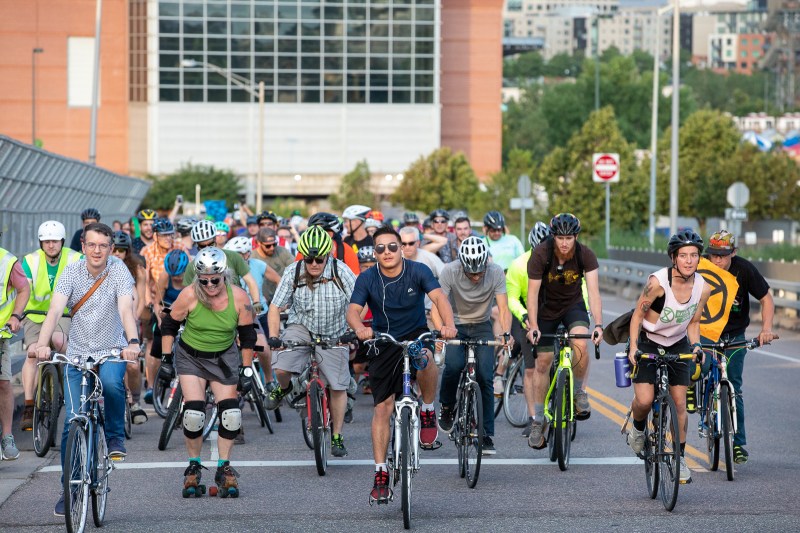Amid Cyclist Deaths, Critical Mass Ride Returns with Call to Action

Critical Mass, the once disruptive bike ride that demanded cyclist rights with an attitude, returned to Denver streets Friday night for the first time since 2012. But there were no roads blocked. No red lights run. And no fists waved at drivers.
Organizers dropped the in-your-face approach after drivers killed two bicyclists last month on Denver streets. But they restarted the activist event to deliver a message.
“We have one ask of you,” said Jonathan Fertig, one of the organizers, to a crowd of roughly 140 before they left the Denver Skate Park. “Take out your phones. Go to dbl.bike.”
The website generates an email to Mayor Hancok and each member of City Council. It reads simply, “I want safe streets in Denver now so I can survive.” As of 1 p.m. today, 99 people had sent the message, according to Rob Toftness, another organizer.
The two recent deaths, which included the grandfather and bike advocate Scott Hendrickson and Alexis Bounds, a mother of two young children, have triggered a strong reaction from cyclists, local media and elected officials. Another ride and vigil that took place earlier last week remembered those cyclists. But Fertig hopes the return of Critical Mass will get city officials to take action fast.
“There’s people who really are dying for better infrastructure,” said Fertig.
The lives lost should be a catalyst to accelerate the city’s plans to expand its network of high-comfort bicycle infrastructure, says Fertig, even over the vocal complaints of neighbors who don’t want to see changes to the streets in front of their homes.

“We’re hoping to gain the attention of elected [officials], gain the attention of Public Works and gain the attention of NIMBYs who think they can block safe infrastructure, even if somebody dies on their street,” he said.
Critical Mass rides started in San Francisco in the ‘90s and spread to other cities, including New York and Denver. The people who organized the events operated under pseudonyms on internet listservs. Their rides often disrupted traffic for hours as hundreds of cyclists took up all lanes of traffic and slowly snaked their way through intersections, regardless of the color of traffic lights. In Denver, the rides stopped in 2008 before they returned again briefly in 2012 when police cited and arrested several cyclists.
“The image you have is that it’s organized by angry 20-somethings,” said Piep van Heuven of Bicycle Colorado, an organization that did not participate in Friday’s ride. “But this one in Denver is going to feel and be different.”
Three men in their 40s, Fertig, Toftness and John Riecke, organized the event openly. They welcomed families and children and led the event without blocking traffic or riding through red lights. In fact, the tone was subdued as many in the crowd kept the recent fatalities — and their own safety — in mind.
“My wife and I are daily commuters. And every day we’re scared to ride,” said Matt Kryman, who arrived to the event with his wife. “Two or three times a week we have a close call.”
In addition to the message for elected officials, Kryman hoped the people opposing bike lanes, like those on Marion Street, would go for a bike ride themselves.
“They should get on a bike and see what it’s like to be a cyclist,” he said. “Then they should really consider if the bike lane would be so difficult for them to handle that it warrants a young mother losing her life.”
To see more photos from the ride, see our Flickr album.
You’re invited to the Streetsblog Scooter Debate August 12. Get tickets here.




